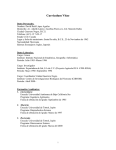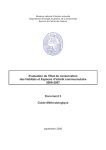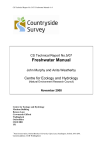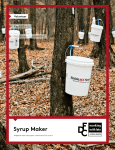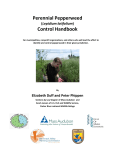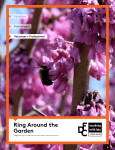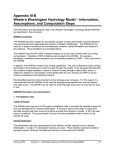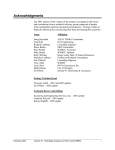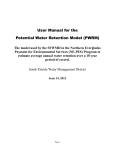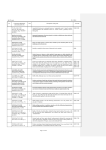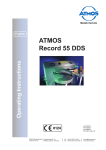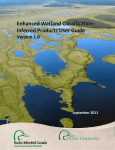Download Site Name/No
Transcript
CRAM Verification Primer for Conducting the Verification of CRAM January 2004 The following summarizes the steps involved in conducting CRAM during the Verification Phase of CRAM development. In the office, prior to visiting the Site: 1.) ____(check here when completed)___ Delineate a draft Assessment Area (AA). 2.) _____ Conduct the “Office Assessment” portion of CRAM scoring, for all applicable metrics and stressors. 3.) _____ Document the rationale for your preliminary decisions and highlight any areas of uncertainty for more focused review in the field. Once in the field: 4.) _____ Walk the entire AA and buffer and verify your draft AA, revising as necessary. 5.) _____ Fill out the first part of the “Supplemental Information Data Sheet”. 6.) _____ Conduct the formal, field assessment of CRAM Metrics. The following data sheets will be used for this phase of data collection: a) _____ The “Wetland Information Data Sheet” specific to the wetland class you are assessing that day b) _____ The “CRAM Metrics Data Sheets”, which incorporate information for the following. (Please document your rationale in selecting the ratings you record.) I. _____ The “Abiotic Patch Richness Data Sheet” II. _____ The “Biotic Patch Richness Data Sheet” III. _____ The “Plant Community Integrity” set of data sheets 7.) _____ Conduct the field assessment of CRAM Stressors using the “CRAM Stressor Index Data Sheet” 8.) _____ Fill out the second part (remainder) of the “Supplemental Information Data Sheet”. Remember to take photographs and/or make sketches of your site and any noteworthy features you encountered during the assessment. CRAM Primer (p 2 of 3) Back in the office: 9.) _____ Enter your data into the Access Database provided by SCCWRP. 10.) After completing the above steps for all of your sites, forward the following deliverables to SCCWRP: a.) A copy of the following for each of your sites: I. II. III. IV. V. VI. VII. VIII. _____ “Supplemental Information Data Sheet” _____ “Wetland Information Data Sheet” _____ “CRAM Metrics Data Sheet” _____ “Abiotic Patch Richness Data Sheet” _____ “Biotic Patch Richness Data Sheet” _____ “Plant Community Integrity” set of data sheets _____ “CRAM Stressor Index Data Sheet” _____ an aerial of the site indicating the AA that you used b.) The most recent CRAM Version 2.0 (dated 27 January 2004) with your comments inserted using “Track Changes”. Please accept all previouslytracked changes before incorporating your own. c.) A technical memo from each team summarizing feedback and recommended changes relating to: o Metrics and attributes o Stressors o Possible future calibration measures d.) e.) Digital photographs taken during your site visits along with clear descriptions of location, and features/items of interest that the photograph depicts Any suggestions/input on data analysis CRAM Primer (p 3 of 3) For CRAM Verification, please keep the following points in mind: • If, when scoring your wetland for a given metric, you feel that the table of options (e.g. A – D) does not adequately describe the situation at hand, and an intermediate value is needed, rather than scoring the wetland as such (e.g., “B.5”), please assign whichever established category best describes the situation (e.g. “B”) and provide a comment explaining why what you chose was not an ideal descriptor and how you would modify it. • Please take photographs liberally during your site visits. Your photographs should focus on examples of different “states” for each metric and areas of potential confusion. Label each photo with the date, site, and subject of the photo. Keep good records of what your pictures depict, as we may use some of them to demonstrate “prototype” conditions for the various metrics. • For Estuarine and Coastal Lagoon wetlands with an open mouth at the time of assessment, it is preferable that you conduct CRAM at low tide, in order to be able to assess as many of the Abiotic Structure features as possible. • If you are conducting CRAM on a tidal wetland, and it is not clear whether the wetland is best classified as a coastal lagoon or an estuary, then conduct the assessment for BOTH classes. The only metric that differs between these two wetland classes is Hydroperiod, so rate the wetland according to both versions of this metric. Make a clear note on the data sheet that this is what you did. • For Riverine wetlands, please take good notes on the plants and other features you used to determine the lateral extents of the AA, and think of any comments you may have that can assist in drafting clearer guidance on the issue. SUPPLEMENTAL INFORMATION DATA SHEET (p1 of 2) The first portion of this data sheet is to be filled out before beginning the formal CRAM assessment (assignment of CRAM Metric and Stressor values.) The second portion is to be completed following the CRAM Metric/Stressor assessment. Site Name/No.: Date: Wetland Class: Investigator(s): In the following table, provide a “first-impression” (Gestalt) assignment of condition level for the wetland based on each of 4 wetland attributes, on a scale of 1 - 10, with “1” equivalent to the lowest possible quality, and “10”, the highest. Also provide an overall rating for the wetland as a whole. In the last column, explain your reasoning in assigning the ratings you chose. Be as broad (“big-picture”) as possible in your interpretation of the attributes, rather than limiting yourself to what you know of CRAM scoring criteria. Attribute Landscape Context Hydrology Biological Structure Physical Structure Overall General Condition (1 to 10) Explanation of Condition-Rating Assignment SUPPLEMENTAL INFORMATION DATA SHEET (p2 of 2) Water Condition (circle all that apply): Dry Saturated Ponded Flowing Clear Cloudy Muddy Other Algae Trash Foam Oil Dominant Plant Communities (List all plant communities observed, using the Sawyer & Keeler-Wolf series provided in Appendix 4 of the CRAM User’s Manual. Include estimated % cover of each.) Community Name % cover Community Name % cover ************************************************************************************** The following information is to be filled out after completing the CRAM Metrics and Stressors portion of the Verification for a given site. Evidence of Wildlife Use (list any species that were observed during the site assessment) Invertebrate: Reptile: Fish: Bird: Amphibian: Mammal: User Questionnaire: Were all the metrics relevant? Were there any missing metrics? Were there specific metrics that didn’t work well, or that need some adjustment? Was the stressor index relevant? Were there any missing stressors? Was the AA delineation appropriate? Did the outcome of CRAM reflect your initial perception of the site? Explain. RIVERINE Wetland Information Data Sheet Site Name/No. Date (m/d/y) Investigators Watershed County GPS Coordinates Upstream limit (as NAD 83 lat./lon.): of AA: Assessment Area Size (ha) Total Office Time (hrs) Downstream limit of AA: Restoration/Mitigation Status CRAM Field Times Start: Stop: Do you have previous experience with this site, excluding work done during the office assessment? If yes, please elaborate: Which best describes the gradient1 of the reach you are assessing (circle one): high low What is the apparent hydrologic flow regime2 of the reach you are assessing (circle one): perennial intermittent ephemeral If applicable, which best describes the current (seasonal) flow condition of the stream (circle one)?: low-flow (base flow) high-flow Briefly describe the up- and downstream features used to delineate the Assessment Area: Upstream: Downstream: Briefly describe the streamside features used to delineate the Assessment Area: 1 High-gradient streams are defined as those that flow down an incline of ≥ 2 %. Low-gradient streams are on gentle slopes of < 2 %. 2 The hydrologic flow regime of a stream describes the frequency with which the channel conducts water. Perennial streams conduct water all year long, whereas ephemeral streams conduct water only during and immediately following precipitation events. Intermittent streams are dry for part of the year, but conduct water for periods longer than ephemeral streams, as a function of watershed size and water source. DEPRESSIONAL Wetland Information Data Sheet Site Name/No. Date (m/d/y) Investigators Watershed County Wetland Size (ha) GPS Coordinates of center of AA (as NAD 83 lat./lon.) Assessment Area Size (ha) Total Office Time (hrs) Restoration/Mitigation Status CRAM Field Times Start: Stop: Do you have previous experience with this site, excluding work done during the office assessment? If yes, please elaborate: Which best describes the type of depressional wetland: other (specify): freshwater marsh alkaline marsh vernal pool alkali flat Which best describes the hydrologic state of the wetland at the time of assessment (circle one) ? ponded/inundated saturated soil, but no surface water dry What is the apparent hydrologic regime3 of the wetland (circle one): long-duration medium-duration short-duration Does your wetland connect with the floodplain of a nearby stream? (circle one) yes / no Is the topographic basin of the wetland distinct or indistinct4 ? (circle one) If indistinct, please explain how you went about defining the Assessment Area. 3 Long-duration depressional wetlands are defined as supporting surface water for > 9 months of the year (in > 5 out of 10 years.) Medium-duration depressional wetlands are defined as supporting surface water for between 4 and 9 months of the year. Short-duration wetlands possess surface water between 2 weeks and 4 months of the year. 4 An indistinct topographic basin is one that lacks obvious boundaries between wetland and upland. Examples of such features are seasonal, depressional wetlands in very low-gradient landscapes, such as vernal pool complexes and large wet meadows, which may be intricately interspersed with uplands or seemingly homogeneous over very large areas. SPRING AND SEEP Wetland Information Data Sheet Site Name/No. Date (m/d/y) Investigators Watershed County Wetland Size (ha) GPS Coordinates of center of AA (as NAD 83 lat./lon.) Assessment Area Size (ha) Total Office Time (hrs) Restoration/Mitigation Status CRAM Field Times Start: Stop: Do you have previous experience with this site, excluding work done during the office assessment? If yes, please elaborate: Does the spring/seep occur on a discernible slope? (circle one) yes / no Are there any distinct channels associated with the wetland (e.g. a visible outflow?) (circle one) yes / no If yes, briefly describe the channel(s). Briefly describe the features that were used to delineate the Assessment Area: LACUSTRINE Wetland Information Data Sheet Site Name/No. Date (m/d/y) Investigators Watershed County Wetland Size (ha) GPS Coordinates of center of AA (as NAD 83 lat./lon.) Assessment Area Size (ha) Total Office Time (hrs) Restoration/Mitigation Status CRAM Field Times Start: Stop: Do you have previous experience with this site, excluding work done during the office assessment? If yes, please elaborate: Is the lake natural or man-made ? (circle one) Is the lake impounded by a dam? (circle one) yes / no Which situation best describes the hydrologic connectivity of the lake? The lake is (circle one): in-channel within a floodplain disconnected/isolated Briefly describe the features that were used to delineate the Assessment Area: ESTUARINE Wetland Information Data Sheet Site Name/No. Date (m/d/y) Investigators Watershed County Wetland Size (ha) GPS Coordinates of center of AA (as NAD 83 lat./lon.) Assessment Area Size (ha) Total Office Time (hrs) Restoration/Mitigation Status CRAM Field Times Start: Stop: Do you have previous experience with this site, excluding work done during the office assessment? If yes, please elaborate: Briefly describe the features that were used to delineate the Assessment Area: What time was the closest high or low tide coinciding with the field visit?: Tide (circle one): high / low Time: Based on the above information, what best describes the tidal stage over the course of the time spent in the field* (circle one): high tide * Note: It is recommended that the assessment be conducted during low tide. low tide COASTAL LAGOON Wetland Information Data Sheet Site Name/No. Date (m/d/y) Investigators Watershed County Wetland Size (ha) GPS Coordinates of center of AA (as NAD 83 lat./lon.) Assessment Area Size (ha) Total Office Time (hrs) Restoration/Mitigation Status CRAM Field Times Start: Stop: Do you have previous experience with this site, excluding work done during the office assessment? If yes, please elaborate: Briefly describe the features that were used to delineate the Assessment Area: Is the mouth of the lagoon open at the time of the assessment? (circle one): yes / no Complete the following only if the lagoon mouth is open: What time was the closest high or low tide coinciding with the field visit?: Tide (circle one): high / low Time: Based on the above information, what best describes the tidal stage over the course of the time spent in the field∗ (circle one): high tide ∗ low tide Note: Where feasible, it is recommended that the assessment be conducted when the lagoon mouth is open, and furthermore suggested that the assessment occur during low tide. CRAM METRICS DATA SHEET (p1 of 1) Site Name/No. Investigators Wetland Class Office Score Landscape Context % of AA w/Buffer Ave Buffer Width Buffer Condition Hydrology Source of Water Hydroperiod Upland connection Abiotic Structure Abiotic Patch Richness Topographic Complexity Sediment Integrity Biotic Structure Organic Matter Accum. Biotic Patch Richness Vertical Structure Interspersion/Zonation Plant Comm Integrity Stressor Index Hydrology Abiotic Structure Biotic Structure Adjacent Land Use Subtotal Photograph numbers: Field Score Date (m/d/y) Comment Lacustrine Lagoon X X X X X X (X) X X X (X) X (X) X X X X X X X X X X X X X X X X X X X X X X (X) (X) X (X) (X) X X X X X X X X (X) (X) X X X (X) (X) X X X X X X X X X X X X X X X X X X X 18 X 14 (8) X Total Number of Possible Patch Types X 18 (13) 10 6 14 Slope Estuarine Mudflats and/or Sandflats/Beaches Pannes on floodplain or exposed lake/lagoon bed In-channel Bars Islands (larger than Slump Blocks) Open Water (ponds, lakes, stream, slough surfaces) Interfluves on floodplain Tributary Channels and/or Ditches Scour Pits or pools on floodplain Debris Jams or Wrackline in channel or on floodplain Hummocks and/or Sediment Mounds Benches in channels or along shorelines Natural Levees Persistent Slump Blocks in channels or along shorelines Pools in-channels on exposed shorelines Swales in secondary channels on floodplains or along shorelines Riffles and Runs in channels Micro-topographic Relief (rills, sediment ribbons on bars, variegated shorelines and banks, burrows, etc) Other Abiotic Patch Type Present? Riverine Depressional ABIOTIC PATCH RICHNESS DATA SHEET (p1 of 1) X X X Abiotic Patch Richness (those present, expressed as a percent of all possible patch types for that wetland class) Note: X’s in parentheses (X) indicate features that do not apply in tidal wetlands during high tide, or in lagoons with a closed mouth at the time of assessment (regardless of tidal stage.) The reduced total number of features possible, in such situations, is provided in parentheses at the bottom of the table. Lagoon Depressional Slope Lacustrine X X X X X X X X X X X X X (X) X X X X X X X X X X X X X X X X X X X X X X X X X X X X X X X X X X X X X X X X X X X X X X X X X X X X X X X X X X X X X X X X X X X X X X X X X X X X X X X X X X X X X X Riverine X 20 18 (17) 16 18 ShrtMonocot Estuarine SubBed RootBed FreeFloat EmDicots X X MedMonocot TallMonocot GCHerbs TallHerbs Shrubs ShortDecTree TallDecTree ShortTree TallTree Moss Macroalgal Shellfish DiatomMat Snags 15 Total Number of Possible Patch Types AqBed 20 Fully submerged aquatic bed (e.g., Vallisneria, Hydrilla, Zostera) Submergent bed (e.g., Potamogeton, Myriophyllum) Rooted-floating bed (e.g., Ruppia, Hydrocotyle, Nymphaea) Free-floating bed (e.g., Lemna, Azolla) Emergent dicot beds (e.g., Polygonum, Plantago, Plagiobothrys) Short emergent monocot beds (e.g., Distichlis, Eleocharis, short Juncus) (< 35 cm tall) Medium emergent monocot beds (e.g. Sparganium, Phalaris, medium-size Scirpus) (35 cm to 1.5 m tall) Tall emergent monocot beds (e.g., Typha, Arundo, tall Scirpus) (> 1.5 m tall) Groundcover herbs and forbs (e.g., Ranunculus, Potentilla, Trifolium, Sagittaria ( < 10 cm tall) Tall herbs and forbs and ferns (e.g., Lythrum, Conium, Berula, Delphinium, Woodwardia ( > 10 cm tall) Shrubs (e.g., Baccharis, Grindelia, Ribes, Rubus) Short deciduous trees (e.g., Sambucus, Salix, Cornus, young Alnus, young Plantanus, young Acer ( < 6 m tall) Tall deciduous trees (e.g., old Acer, old Plantanus, old Alnus( > 6 m tall) Short non-deciduous trees (e.g., Tamarix, young Picea, young Pinus ( < 6 m tall) Tall non-deciduous trees (e.g., old Picea, old Pinus ( > 6 m tall) Moss bed Macroalgal mat/Periphyton Shellfish bed Diatom felt or mat Standing tree snags Present? Biotic Patch Type (check for presence) Code name BIOTIC PATCH RICHNESS DATA SHEET (p1 of 1) Biotic Patch Richness (those present, expressed as a percent of all possible patch types for that wetland class) Note: X in parentheses (X) indicates a feature that does not apply in depressional wetlands when the wetland is not ponded. The reduced total number of features possible, in such a situation, is provided in parentheses at the bottom of the table. PLANT COMMUNITY INTEGRITY DATA SHEETS (p1 of 4) Worksheet 1 (of 5) to determine dominant plant species for the four vegetation layers*. Short Herbs Layer (herbaceous plants that have a height of < 1.5 m) Plant species Percent Cover Rank Dominant? (check one if appl.) Based on Based on 20% Rule 50% Rule Invasive? Total Percent Coverage 50% of Total Coverage 20% of Total Coverage % of Co-dominant Species that are Invasive What is the total number of co-dominant species for the short herb layer? * For each vegetation layer in the AA, the co-dominant species are those that rank highest based on their percent cover, relative to other vegetation within the same layer. Species are ranked in descending order of relative percent cover for the vegetation layer in question. Then, in order of their rank, all species that cumulatively reach 50% of the total coverage for that layer, plus any other species that individually comprise 20% or more of the total coverage of that layer, are included as co-dominants. For more details, see Appendix 5 of the CRAM User’s Manual. Results for all layers are entered in Worksheet 5. PLANT COMMUNITY INTEGRITY DATA SHEETS (p2 of 4) Worksheet 2 (of 5) to determine dominant plant species for the four vegetation layers. Tall Herbs Layer (herbaceous plants that have a height of > 1.5 m) Plant species Percent Cover Total Percent Coverage 50% of Total Coverage 20% of Total Coverage % of Co-dominant Species that are Invasive What is the total number of co-dominant species for the tall herb layer? Rank Dominant? (check one if appl.) Based Based on on 20% 50% Rule Rule Invasive? PLANT COMMUNITY INTEGRITY DATA SHEETS (p3 of 4) Worksheet 3 (of 5) to determine dominant plant species for the four vegetation layers. Shrub Layer (multiple stems, < 3 m in height) Plant species Percent Cover Rank Total Percent Coverage 50% of Total Coverage 20% of Total Coverage % of Co-dominant Species that are Invasive What is the total number of co-dominant species for the shrub layer? Dominant? (check one if appl.) Based on Based on 20% Rule 50% Rule Invasive? PLANT COMMUNITY INTEGRITY DATA SHEETS (p4 of 4) Worksheet 4 (of 5) to determine dominant plant species for the four vegetation layers. Tree Layer (single trunk, > 3 m in height) Percent Cover Plant species Dominant? (check one if appl.) Based on Based on 50% Rule 20% Rule Rank Invasive? Total Percent Coverage 50% of Total Coverage 20% of Total Coverage % of Co-dominants Species that are Invasive What is the total number of co-dominant species for the tree layer? **************************************************************** Worksheet 5 (of 5) to assess Plant Community Integrity, based on Worksheets 1 – 4. % of Co-dominants that are Invasive Trees: Shrubs: Tall Herbs: Short Herbs: Average across the 4 Layers: Draft Rating of Plant Community Integrity (based on result of Worksheet 5 above) Code Percent of Co-Dominants that are Invasive A B C D 0-25% > 25-50% > 50-75% > 75-100% CRAM STRESSOR INDEX DATA SHEET (p1 OF 2) Site Name/No. Investigators • • • • • • • • • • • • • • • • • • • • • • • Outside of AA Within AA Where to Assess • • • • • • Wetland Class Date (m/d/y) Stressor Index Raw Scores (0 to 10: 0 = not present, 10 = highest stress) Hydrology Point Source (PS) Discharges (POTW, other non-stormwater discharge) Non-point Source (Non-PS) Discharges (urban runoff, farm drainage) Flow diversions Dams (reservoirs, detention basins, recharge basins) Flow obstructions (culverts, paved stream crossings) Weir/drop structure, tide gates Dredged inlet/channel Engineered channel (riprap, armored channel bank, bed) Dike/levees, fills (e.g. from construction) Groundwater extraction Other Subtotal by Attribute Abiotic Structure Filling or dumping of sediment or soils (N/A for restoration areas) Grading/ compaction (N/A for restoration areas) Plowing/Discing (N/A for restoration areas) Resource extraction (sediment, gravel, oil and/or gas) Vegetation management Excessive sediment or organic debris from watershed Nutrient-impaired (PS or Non-PS pollution) Heavy-metal-impaired (PS or Non-PS pollution) Pesticide- or trace-organics impaired (PS or Non-PS pollution) Bacteria- and pathogen- impaired (PS or Non-PS pollution) Trash or refuse Other Subtotal by Attribute Office Score Final Score Office Score Final Score CRAM STRESSOR INDEX DATA SHEET (p2 OF 2) Site Name/No. Investigators Outside of AA Within AA Where to Assess • • • • • • • • • • • • • • • • • • • • • • • • • • • • Wetland Class Date (m/d/y) Stressor Index Raw Scores (continued) Biotic Structure Mowing, grazing, excessive herbivory Excessive human visitation Predation and habitat destruction by feral animals Tree cutting/sapling removal Removal of woody debris Treatment of invasive and nuisance plant species Pesticide application or vector control Evidence of fire Evidence of flood Biological resource extraction (fisheries, aquaculture) Other Subtotal by Attribute Landscape Context (Adjacent Land Use) Urban residential Industrial/commercial Military training/Air traffic Dryland farming Intensive row-crop agriculture Orchards/nurseries Commercial feedlots Dairies Ranching Transportation corridor Rangeland Sports fields and urban parklands Passive Recreation (birdwatching, hiking, etc.) Active Recreation (off-road vehicles, mountain biking, hunting, fishing) Physical resource extraction (rock, sediment, oil/gas) Biological resource extraction (aquaculture, commercial fisheries) Other Subtotal by Attribute Office Score Final Score Office Score Final Score




















